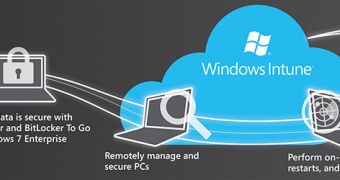Windows Intune, the tool that Microsoft released to offer PC management and security features through the cloud, has been optimized to deliver a great experience to those who need it.
The same as other products from the Redmond-based software giant, Windows Intune is taking a people-centric approach, and it also suffered the influence of the new design philosophy in Windows 8.
Overall, the management capabilities of the application should meet the needs of any company or IT professional in charge with supervising a multitude of devices, Eric Main, director of marketing of Windows Intune, tells us.
During a presentation of Windows Intune at the TechEd EMEA 2012 conference in Amsterdam, he also demoed how users themselves could take advantage of the features that Windows Intune has to offer.
The tool was designed so as to connect to a company's on-premises Active Directory, and to pull security groups from there. In a way, it behaves the same as another Microsoft product, namely Office 365, Eric Main explains.
When it comes to management, Windows Intune offers support for customizations, alerts, system view, computer summary and the like, and it offers a unified view of all devices associated with an account.
There are two types of management that the tool can deliver, one at the user level, and the other at the device level, each with its own advantages.
While being easy to set up through cloud services, the tool also creates a link between the user and the devices he / she owns within the company.
Of course, one can bring own devices into the mix, which would add an extra level of management rights on the user side.
In fact, this is one of the aspects that Eric Main stressed upon during his presentation, namely that individuals have the possibility to participate in the management of their devices, as long as these are personal PCs, phones or tablets that they chose to bring in the enterprise environment.
At the user level, the company can ask the user to install specific applications on devices but, in the end, users are those who can choose whether they do want to install the app or not.
When the management at device level comes into play, applications can be pushed for installation, as long as these are not mobile phones or tablets. If they are, the user will, again, have the freedom to opt out.
Windows Intune also comes with support for setting Exchange ActiveSync policies for a specific device, to offer better connection with mobile devices in the field.

 14 DAY TRIAL //
14 DAY TRIAL //